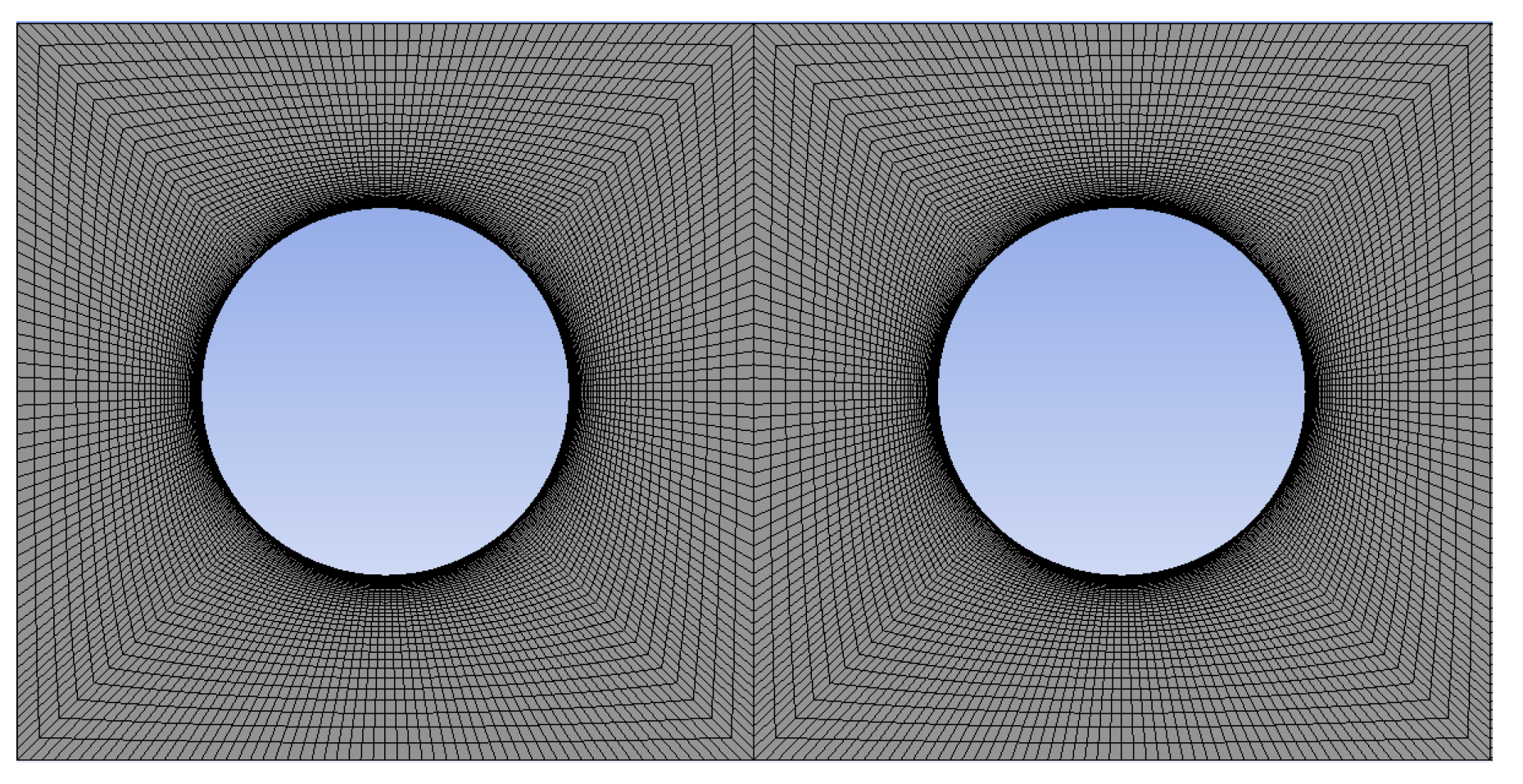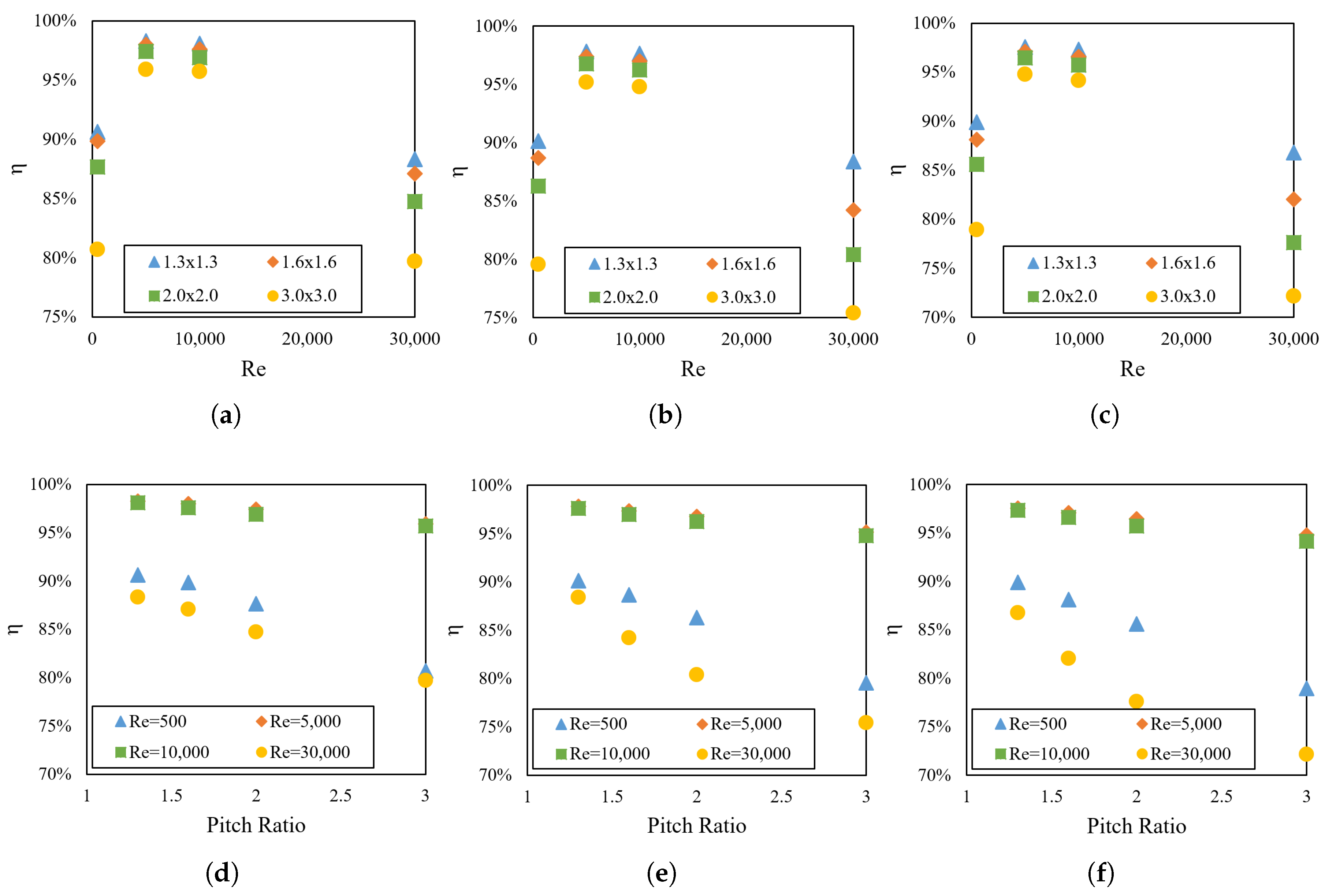Energy and Exergy Analyses of Tube Banks in Waste Heat Recovery Applications
Abstract
:1. Introduction
2. Mathematical Model
2.1. Governing Equations
- Flow is two-dimensional and transient;
- Inlet velocity of the fluid is uniform;
- Thermo-physical properties of the fluid are constant;
- Radiation heat transfer effects are negligible.
2.2. Thermodynamics Analysis
2.2.1. Energy Analysis
2.2.2. Exergy Analysis
3. Geometry, Mesh Generation and Boundary Conditions
3.1. Geometry Formation and Boundary Conditions
3.2. Mesh Generation and Grid Independence Study
Time Independence Study and Solver Settings
4. Results and Discussions
4.1. Validation
4.2. Thermodynamics Results
4.2.1. Energy Analysis
4.2.2. Exergy Analysis
5. Conclusions
- Although some other studies [28] indicated energy efficiencies over 99%, the values from this study varied from 72–98.3%. This is mainly due to the artificial introduction of heat leakage and the consideration of viscous dissipation. The highest energy efficiencies were obtained at a Reynolds number of 5000 for each case because the effect of viscous dissipation did not have a considerable effect on the total energy efficiency for low Reynolds numbers. Energy efficiencies were also compared for different pitch ratios at the same Reynolds numbers, and it was found that energy efficiency decreased with increasing pitch ratios. Moreover, increasing the number of inline tubes increased the energy efficiency because of high convective heat transfer.
- Exergy efficiencies, on the other hand, ranged from 40–64%. They were lower than the corresponding energy efficiencies because of exergy destruction and heat leakage. The highest effect of entropy generation due to viscous dissipation was found with three cylinders due to the fact that the viscous effect was higher than the heat transfer effect on the total entropy generation. Furthermore, the highest exergy efficiency was obtained at a Reynolds number of 5000. Although the energy efficiency and exergy efficiency trends were very similar, the difference between the highest and lowest efficiencies was considerably higher in the exergy case. Therefore, it can be said that viscous dissipation has more effect on exergy efficiency than energy efficiency.
Author Contributions
Acknowledgments
Conflicts of Interest
References
- Fowler, A.J.; Bejan, A. Correlation of optimal sizes of bodies with external forced convection heat transfer. Int. Commun. Heat Mass Transf. 1994, 21, 17–27. [Google Scholar] [CrossRef]
- Korukcu, M. 2D Temperature Analysis of Energy and Exergy Characteristics of Laminar Steady Flow across a Square Cylinder under Strong Blockage. Entropy 2015, 17, 3124–3151. [Google Scholar] [CrossRef]
- Melhem, O.A.; Sahin, A.Z.; Yilbas, B.S. Entropy Generation Due To External Fluid Flow and Heat Transfer From a Cylinder Between Parallel Planes. Therm. Sci. 2017, 21, 841–848. [Google Scholar] [CrossRef]
- Abu-Hijleh, B. Entropy Generation in Laminar Convection from an Isothermal Cylinder in Cross Flow. Energy 1998, 23, 851–857. [Google Scholar] [CrossRef]
- Poulikakos, D.; Johnson, J.M. Second law analysis of combined heat and mass transfer phenomena in external flow. Energy 1989, 14, 67–73. [Google Scholar] [CrossRef]
- Ibrahim, E.; Moawed, M. Forced convection and entropy generation from elliptic tubes with longitudinal fins. Energy Convers. Manag. 2009, 50, 1946–1954. [Google Scholar] [CrossRef]
- Khan, W.A.; Culham, J.R.; Yovanovich, M.M. Optimal Design of Tube Banks in Crossflow Using Entropy Generation Minimization Method. J. Therm. Heat Transf. 2007, 21, 372–378. [Google Scholar] [CrossRef] [Green Version]
- Gharbi, N.E.; Kheiri, A.; Ganaoui, M.E.; Blanchard, R. Numerical optimization of heat exchangers with circular and non-circular shapes. Case Studies Therm. Eng. 2015, 6, 194–203. [Google Scholar] [CrossRef]
- Khan, W.A.; Culham, J.R.; Yovanovich, M.M. The Role of Fin Geometry in Heat Sink Performance. J. Electron. Packag. 2006, 128, 324–330. [Google Scholar] [CrossRef]
- Cuce, P.M.; Riffat, S. A comprehensive review of heat recovery systems for building applications. Renew. Sustain. Energy Rev. 2015, 47, 665–682. [Google Scholar] [CrossRef]
- Pandiyarajan, V.; Chinna Pandian, M.; Malan, E.; Velraj, R.; Seeniraj, R.V. Experimental investigation on heat recovery from diesel engine exhaust using finned shell and tube heat exchanger and thermal storage system. Appl. Energy 2011, 88, 77–87. [Google Scholar] [CrossRef]
- Bari, S.; Hossain, S.N. Waste heat recovery from a diesel engine using shell and tube heat exchanger. Appl. Therm. Eng. 2013, 61, 355–363. [Google Scholar] [CrossRef]
- Wang, D.; Ling, X.; Peng, H.; Liu, L.; Tao, L. Efficiency and optimal performance evaluation of organic Rankine cycle for low grade waste heat power generation. Energy 2013, 50, 343–352. [Google Scholar] [CrossRef]
- Mohammadi, A.; Ashjari, M.A.; Sadreddini, A. Exergy analysis and optimisation of waste heat recovery systems for cement plants. Int. J. Sustain. Energy 2016, 37, 115–133. [Google Scholar] [CrossRef]
- Maatouk, C.; Slim, R. Exergy And Energy Analysis Of Waste Heat Recovery Options For Cooling Capacity Production. In Proceedings of the 15th International Refrigeration and Air Conditioning Conference at Purdue, Mar Roukos, Mkalle’s, Lebanon, 14–17 July 2014. [Google Scholar]
- López, L.; Blanco, J.M.; Bonilla, J.J.; Bacza, S.; Sala, J.M. Determination of energy and exergy of waste heat in the industry of the Basque country. Appl. Therm. Eng. 1998, 18, 187–197. [Google Scholar] [CrossRef]
- Žkauskas, A. Heat Transfer from Tubes in Crossflow. Adv. Heat Transf. 1987, 18, 87–159. [Google Scholar]
- Žkauskas, A.; Ulinskas, R. Efficiency Parameters for Heat Transfer in Tube Banks. Heat Transf. Eng. 1985, 6, 19–25. [Google Scholar] [CrossRef]
- Khan, W.A.; Culham, J.R.; Yovanovich, M.M. Convection heat transfer from tube banks in crossflow: Analytical approach. Int. J. Heat Mass Transf. 2006, 49, 4831–4838. [Google Scholar] [CrossRef]
- ANSYS, Inc. ANSYS FLUENT User’s Guide; ANSYS, Inc.: Canonsburg, PA, USA, 2011. [Google Scholar]
- Bahaidarah, H.M.S.; Ijaz, M.; Anand, N.K. Numerical Study of Fluid Flow and Heat Transfer Over a Series of In-Line Noncircular Tubes Confined in a Parallel-Plate Channel. Numerical Heat Transf. 2006, 50, 97–119. [Google Scholar] [CrossRef]
- Sayed Ahmed, S.A.; Mesalhy, O.M.; Abdelatief, M.A. Effect of Longitudinal-External-Fins on Fluid Flow Characteristics for Wing-Shaped Tubes Bundle in Crossflow. J. Therm. 2015. [Google Scholar] [CrossRef]
- Ibrahim, T.A.; Gomaa, A. Thermal performance criteria of elliptic tube bundle in crossflow. Int. J. Therm. Sci. 2009, 48, 2148–2158. [Google Scholar] [CrossRef]
- Sayed Ahmed, S.A.; Ibrahiem, E.Z.; Mesalhy, O.M.; Abdelatief, M.A. Effect of attack and cone angels on air flow characteristics for staggered wing shaped tubes bundle. Heat Mass Transf. 2015, 51, 1001–1016. [Google Scholar] [CrossRef]
- Mangrulkar, C.K.; Dhoble, A.S.; Chakrabarty, S.G.; Wankhede, U.S. Experimental and CFD prediction of heat transfer and friction factor characteristics in cross flow tube bank with integral splitter plate. Int. J. Heat Mass Transf. 2017, 104, 964–978. [Google Scholar] [CrossRef]
- MacPhee, D.; Dincer, I.; Beyene, A. Numerical simulation and exergetic performance assessment f charging process in encapsulated ice thermal energy storage system. Energy 2012, 41, 491–498. [Google Scholar] [CrossRef]
- Kanoglu, M.; Cengel, Y.A.; Dincer, I. Efficiency Evaluation of Energy Systems; Springer: New York, NY, USA, 2012. [Google Scholar]
- MacPhee, D.; Dincer, I. Thermodynamic Analysis of Freezing and Melting Processes in a Bed of Spherical PCM Capsules. J. Sol. Energy Eng. 2009, 131. [Google Scholar] [CrossRef]









| Material (-) | (J/kg·K) | (kg/m) | k (W/m·K) | (Pa·s) |
|---|---|---|---|---|
| HTF (air) | 1011 | 0.897 | 0.0324 |
| Nusselt Number Correlation | |
|---|---|
| 100–1000 | = 0.9 |
| 1000– | = 0.52 |
| Pitch Ratio | Reynolds Number | 8 Cylinders | 4 Cylinders | 3 Cylinders | ||||||
|---|---|---|---|---|---|---|---|---|---|---|
| HT | VD | HL | HT | VD | HL | HT | VD | HL | ||
| 1.3 × 1.3 | 500 | 90.62 | 0.00 | 9.38 | 90.14 | 0.00 | 9.85 | 89.88 | 0.00 | 10.11 |
| 5000 | 98.27 | 0.29 | 1.44 | 97.80 | 0.30 | 1.89 | 97.55 | 0.33 | 2.11 | |
| 10,000 | 98.08 | 1.11 | 0.81 | 97.63 | 1.26 | 1.12 | 97.33 | 1.41 | 1.26 | |
| 30,000 | 88.33 | 11.38 | 0.28 | 88.40 | 11.18 | 0.42 | 86.78 | 12.75 | 0.47 | |
| 500 | 89.86 | 0.00 | 10.14 | 88.67 | 0.00 | 11.33 | 88.13 | 0.00 | 11.87 | |
| 5000 | 97.97 | 0.34 | 1.69 | 97.37 | 0.40 | 2.22 | 97.08 | 0.46 | 2.46 | |
| 10,000 | 97.58 | 1.46 | 0.96 | 96.96 | 1.73 | 1.30 | 96.58 | 1.97 | 1.45 | |
| 30,000 | 87.08 | 12.57 | 0.35 | 84.23 | 15.30 | 0.47 | 82.03 | 17.45 | 0.52 | |
| 500 | 87.64 | 0.00 | 12.35 | 86.29 | 0.00 | 13.71 | 85.62 | 0.00 | 14.37 | |
| 5000 | 97.43 | 0.41 | 2.16 | 96.77 | 0.51 | 2.72 | 96.44 | 0.58 | 2.98 | |
| 10,000 | 96.88 | 1.89 | 1.23 | 96.23 | 2.20 | 1.58 | 95.73 | 2.53 | 1.74 | |
| 30,000 | 84.73 | 14.83 | 0.44 | 80.41 | 19.03 | 0.56 | 77.61 | 21.79 | 0.61 | |
| 500 | 80.70 | 0.00 | 19.30 | 79.56 | 0.00 | 20.44 | 78.94 | 0.00 | 21.05 | |
| 5000 | 95.88 | 0.51 | 3.61 | 95.16 | 0.63 | 4.21 | 94.78 | 0.70 | 4.52 | |
| 10,000 | 95.71 | 2.22 | 2.07 | 94.78 | 2.76 | 2.46 | 94.16 | 3.18 | 2.66 | |
| 30,000 | 79.70 | 19.54 | 0.75 | 75.42 | 23.69 | 0.88 | 72.17 | 26.89 | 0.93 | |
| No. of Cylinders | Pitch Ratio | S (W/K) | S/S | ||||||
|---|---|---|---|---|---|---|---|---|---|
| 500 | 5000 | 10,000 | 30,000 | 500 | 5000 | 10,000 | 30,000 | ||
| 8 | 0.03 | 0.31 | 0.69 | 5.71 | 0.05% | 2.74% | 8.26% | 28.68% | |
| 0.06 | 0.42 | 0.93 | 7.31 | 0.03% | 2.78% | 9.45% | 28.82% | ||
| 0.07 | 0.53 | 1.22 | 9.88 | 0.03% | 3.20% | 11.16% | 29.99% | ||
| 0.10 | 0.71 | 1.64 | 15.01 | 0.04% | 3.71% | 12.02% | 31.67% | ||
| 4 | 0.03 | 0.21 | 0.43 | 3.13 | 0.03% | 2.46% | 8.20% | 26.83% | |
| 0.04 | 0.25 | 0.55 | 4.51 | 0.03% | 3.01% | 10.16% | 30.08% | ||
| 0.05 | 0.31 | 0.69 | 6.16 | 0.02% | 3.64% | 11.97% | 32.69% | ||
| 0.06 | 0.38 | 0.90 | 8.68 | 0.03% | 4.35% | 13.89% | 34.32% | ||
| 3 | 0.02 | 0.17 | 0.35 | 2.65 | 0.03% | 2.60% | 8.79% | 27.91% | |
| 0.03 | 0.20 | 0.44 | 3.87 | 0.02% | 3.35% | 11.06% | 31.27% | ||
| 0.04 | 0.24 | 0.55 | 5.28 | 0.02% | 4.05% | 13.18% | 34.12% | ||
| 0.04 | 0.30 | 0.71 | 7.32 | 0.03% | 4.78% | 15.31% | 35.87% | ||
© 2018 by the authors. Licensee MDPI, Basel, Switzerland. This article is an open access article distributed under the terms and conditions of the Creative Commons Attribution (CC BY) license (http://creativecommons.org/licenses/by/4.0/).
Share and Cite
Erguvan, M.; MacPhee, D.W. Energy and Exergy Analyses of Tube Banks in Waste Heat Recovery Applications. Energies 2018, 11, 2094. https://doi.org/10.3390/en11082094
Erguvan M, MacPhee DW. Energy and Exergy Analyses of Tube Banks in Waste Heat Recovery Applications. Energies. 2018; 11(8):2094. https://doi.org/10.3390/en11082094
Chicago/Turabian StyleErguvan, Mustafa, and David W. MacPhee. 2018. "Energy and Exergy Analyses of Tube Banks in Waste Heat Recovery Applications" Energies 11, no. 8: 2094. https://doi.org/10.3390/en11082094
APA StyleErguvan, M., & MacPhee, D. W. (2018). Energy and Exergy Analyses of Tube Banks in Waste Heat Recovery Applications. Energies, 11(8), 2094. https://doi.org/10.3390/en11082094




